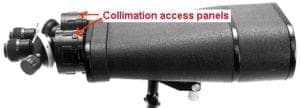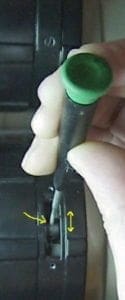Collimation Instructions the 25/40×100 Long-Range Observation Binocular


If you have now determined that a collimation problem exists, how do you correct it? The Oberwerk 100mm models utilize massive porro prisms that “float” on a 3-point platform. This well-designed system is very robust, yet allows ultra-precise adjustment through three access panels on each prism housing. Each access panel is held in place with two small screws. Typical fine adjustment can usually be accomplished by removing the top-most access panel on just one side.


The key is to determine which side needs to move.
If you have determined that the right side image is higher than the left, remove the top left access panel. If the left side is higher than the right, remove the right access panel. Be careful not to drop the access panel screws- they are very small and easy to lose. Once the access panel is removed, you will see a round “nut” with four holes around the sides. To turn the round nut, you will need to find a tool that is a close match to the diameter of the holes in the side of the nut. A small screwdriver, a punch, or even a nail can be used- as long as the tool fits the hole closely enough to allow turning the nut.
To move the left side image upwards, tighten the left nut (turn clockwise). To move the right image up, loosen the right nut (turn counter-clockwise). View through the binocular as you do this to see the effect that turning the nut has on the image position.
Most minor collimation problems can be corrected by adjusting just one of these top-most nuts. Other collimation problems may require the adjustment of the outer side nut (remove the access panel on each side of the prism housings). These nuts adjust left-right movement for each side. Simply watch what happens to the images as you adjust these nuts. With a little practice and experimentation, you will to able to obtain perfect collimation. The ultimate test is to view the night sky. Bright objects such as Jupiter should be well merged, with no double images. Perfect collimation will allow you to view for extended periods with no eyestrain or headaches. If collimation is off by a large amount, or if you have any trouble with the above procedure, please contact Oberwerk technical support at [email protected].
